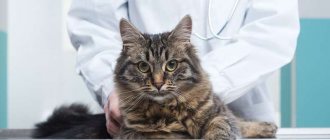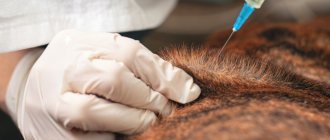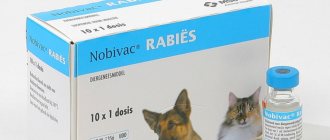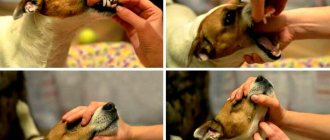Vaccination protects against infections that can lead to the death of the animal. These include several diseases, in particular rabies and leptospirosis, which are also dangerous to humans. But the dog owner does not always have the opportunity to visit a veterinary clinic. In such cases, you need to know how to vaccinate your dog yourself in order to protect it from dangerous viruses and bacteria.
Vaccinations protect against rabies and other infections
Vaccination schedule
Vaccination is carried out according to a specific schedule.
Table 1. Recommended vaccination schedule for dogs
| 8-9 weeks | Vaccination against canine distemper, parvovirus enteritis, infectious hepatitis, adenovirus infection, parainfluenza, leptospirosis. |
| 12 weeks | Revaccination against canine distemper, parvovirus enteritis, infectious hepatitis, adenovirus infection, parainfluenza, leptospirosis, rabies. |
| After changing teeth | Vaccination against canine distemper, parvovirus enteritis, infectious hepatitis, adenovirus infection, parainfluenza, leptospirosis, rabies. |
| 1 year | Vaccination against canine distemper, parvovirus enteritis, infectious hepatitis, adenovirus infection, parainfluenza, leptospirosis, rabies. |
| Annually | Revaccination (canine distemper, parvovirus enteritis, infectious hepatitis, adenovirus infection, parainfluenza, leptospirosis, rabies). |
Attention! Some manufacturers produce vaccines that guarantee protection of the animal from viruses and infections for 3 years. Accordingly, they are administered once every 3 years.
Vaccination is carried out according to a specific schedule
In Russia, dogs are vaccinated against borreliosis and bordetellosis, the causative agents of tracheobronchitis (CB). Whether they are needed is decided by the doctor based on data on the epidemiological situation in the region.
The most common and dangerous diseases that dogs can get
The disadvantage of vaccinations at home is that this fact is not noted in documents - veterinary passports and specialized registers. Therefore, if we are talking about an animal that will travel or take part in exhibitions, then the procedure is carried out in a veterinary clinic. Previously, according to the law, rabies vaccinations were allowed only in government clinics. Now private veterinary clinics are also given such powers.
It has not been proven that vaccination can protect a dog from shingles.
Dogs are also vaccinated against other diseases - parasitic infestations, coronavirus, lichen. But their effectiveness is either low or not proven.
Attention! When choosing a drug, remember its name and manufacturer. Veterinarians recommend vaccinating an animal with the same vaccine throughout its life.
Main stage
During immunization, the rules of asepsis and antiseptics are observed. Use gloves to protect the skin of your hands from possible contact with the product. They put a muzzle on the animal; if it is aggressive, they call a second person to help, who will secure the dog for the duration of the injection. The bottle of medicine is taken out of the refrigerator in advance and kept until a comfortable temperature is reached.
Next, follow the following sequence:
- preparing the composition. For example, the rabies vaccine is available in two derivatives. Before the injection, mix the liquid component with the dry substance to obtain a single dose of the drug. First, the liquid substance is drawn into the syringe, having previously treated the cap with alcohol, then the needle is inserted through the cap into the bottle with the dry component, waiting for complete dissolution and homogeneity of the liquid;
- draw the injection suspension into a syringe, it is advisable to take a new syringe;
- get rid of air. You can do it like this. You will need to take the syringe vertically, press the plunger until liquid flows out of the spout, you can tap the syringe a little, then the bubbles will concentrate together and it will be easier to remove them;
- fix the dog, spread the fur on the withers, wipe the skin with an alcohol solution;
- pull back the skin at the withers, insert a needle 1.5 cm;
- The dog is vaccinated subcutaneously; if administered correctly, the pet will not feel pain. Some drugs are administered intramuscularly, and not at the withers. In such cases, you will need to determine the muscle, having first checked the information with veterinarians, or, in extreme cases, on the Internet;
- knead the injection area, treat again with alcohol;
- stick labels from the bottle into a notebook and indicate the date of re-vaccination;
- Dispose of the vials and the remaining substance.
Read. Vaccinations for piglets from birth at home
Further caring for the dog comes down to monitoring its behavior. Severe reactions may appear in the first hour after the injection. Breathing problems, increased swelling, and anxiety will require going to the clinic and using medications.
Vaccines
In veterinary practice, the following brands of vaccines are used to vaccinate dogs:
- Nobivac;
- Duramun;
- Eurikan;
- Biovac;
- Dipentavak;
- Asterion;
- Multikan and others.
Basically, these are complex products that contain causative agents of major infections, some of them including the rabies virus. The latter include Asterion DHPPiR, Multikan-8.
Attention! Not all domestic vaccines are recognized abroad. Therefore, it is necessary to consult a veterinarian about the drug if you are planning a trip accompanied by an animal.
Decoding the letter values in the names of the product
Vaccines are either live or inactivated. Not all specialists use inactivated products. According to some doctors, they provide weaker immune protection, so preference should be given to “live” formulations.
How the vaccine is administered
It is better to get vaccinated in the morning on a day off. This makes it possible to monitor the dog’s condition all day long.
You can read about how to prepare your dog for vaccination, what to do if complications arise and where is the best place to vaccinate in our article.
Typically, the kit includes two products: the vaccine itself in powder form and a solvent for it. The components are first mixed. To do this, draw up the solvent with a syringe, and then inject it with a needle through the lid into the container with the powder. The mixture is thoroughly shaken until all dry particles are dissolved. Select the injection site:
- subcutaneously - withers area;
- intramuscularly - thigh area.
Place of injection - withers area
Next, the drug is administered into the dog’s body in the following order:
- treat the injection site (if necessary, cut it with scissors);
- wipe the injection site with medical alcohol;
- immobilize the animal using a special bag, towel, or ask another family member to hold it;
- if the injection is given at the withers, a fold of skin is collected on this part, into the base of which a needle is inserted;
- the drug is infused;
- remove the syringe;
- wipe the injection site with alcohol.
The instructions for some drugs say that the injection site must be massaged. More precise instructions regarding the rules and method of administration should be sought in the manufacturer's instructions.
Intranasal vaccines (for example, Nobivac KS) are administered into the nostril. Then the drug is poured into the nasal passage.
Video - How the vaccine is administered
The vaccine should not be used in the following cases:
- bottles or caps are damaged;
- the product has expired;
- the liquid or powder looks different from the description in the instructions.
Personal safety measures
The vaccine spilled on the body is washed off with plenty of running water. If a veterinary drug is accidentally administered to a person, then in such cases, immediately consult a doctor. The specialist is presented with a factory-made vaccine bottle.
Any drug that gets on the skin is washed off with plenty of running water.
The drugs are stored in places inaccessible to children. After use, the product is immediately discarded so as to prevent other animals or people from reaching the containers and used syringes.
First vaccination
The first vaccine is administered twice, regardless of the dog’s age, according to the following scheme:
- Anthelmintic drug - 2 times with an interval of 2 weeks.
- The first vaccination is after 1.5-2 weeks of the second dose of anthelmintic.
- The second vaccination is 3 weeks after the first.
Attention! Re-vaccination is carried out with the same drug with the same quantity and qualitative composition of strains. Using another drug may be dangerous to your pet's health.
Contraindications to vaccination
Vaccinations are given when the dog is healthy. This is important because vaccination puts a strain on the immune system. The body must respond correctly to the substance and fully produce antibodies.
Vaccinations are prohibited for dogs with the following conditions:
- infection with worms;
- illness, including one suffered shortly before;
- exhaustion;
- change of teeth in a puppy.
Also, you cannot plan to administer the vaccine 2 weeks before and after the cupping procedure.
Attention! The body must first be cleared of worms. Dogs are given medications two weeks before vaccination. Parasites reduce the effectiveness of the drug to zero.
Parasites are expelled before vaccination
Another contraindication is previous vaccination. The next one can be carried out no earlier than after 3 weeks.
If on the day of vaccination or one or two days before, the owner notices alarming symptoms in the pet, digestive disorders, changes in behavior, the procedure is postponed.
Subcutaneous injection
A hypodermic injection should be given to the dog at the withers.
- The withers are a small area of a dog's fur where the shoulder blades of the forelimbs meet.
- It is not difficult to find it, since in this place there is a small excess of skin into which the injection will need to be placed.
- Pull back the withers a little and carefully, gradually wind the syringe.
If everything is done correctly, the needle will enter without any problems and the liquid will flow out of it without any effort.
Pregnancy and lactation
It is recommended that your dog be vaccinated before pregnancy occurs. It is possible that vaccine components can penetrate the placenta and cause fetal death or developmental defects. If such a measure is necessary, it is recommended to use only inactivated drugs, which are selected by the veterinarian.
It makes no sense to vaccinate a nursing bitch to protect the offspring. In order for puppies to acquire passive immunity, the female’s body must begin to produce antibodies. To do this, at least a week must pass after the procedure. Antibodies are obtained from the mother through colostrum in the first 36 hours of the offspring's life.
It is better to vaccinate a bitch before pregnancy.
What to do before vaccination
It is important to carry out deworming 10-14 days before vaccination, especially for animals under one year old. If the animal is picked up from the street or there is no reliable information about its past life, deworming is carried out twice with an interval of 14-21 days, and 2 weeks after repeated administration of the anthelmintic drug, vaccinations are given.
“Indoor” dogs also need deworming and vaccination. Without going outside, a pet can become infected with parasites and infections through contact, for example, through the owner’s shoes, which he sniffs.
Vaccination if there is a helminthic infection or failure to comply with the terms of use of the drug will become ineffective: immunity after vaccination is not fully developed, and a developing parasitic disease can aggravate the health of your pet.
Before vaccination, the animal must be clinically healthy: it must have a good appetite, normal urination and stool, and normal body temperature.
Photo: Nat, Inc.
Before vaccination, a mandatory clinical examination of the animal is carried out and information is collected about previous diseases, the dog’s living conditions, what vaccinations it has already received and which manufacturer’s vaccine. The veterinarian measures the dog’s body temperature, measures the body temperature, checks the condition of the mucous membranes and skin, and listens to the heart.
The clinical health of the dog is an important aspect to ensure the animal has proper immune protection.
Do not hide alarming symptoms from the doctor: lethargy, disorders of appetite and bowel movements, changes in the animal’s behavior. Vaccination should be postponed until the animal recovers.
If the animal lives with you for less than 2 weeks, then vaccination should not be done either: there is a possibility that the dog is in the latent period of the diseases against which the vaccine is being given. If this is so, then vaccination will complicate the course of the disease.
Features of puppy vaccination
Puppies that are breastfed acquire passive immunity from their mother, provided that she is vaccinated in a timely manner. The female passes antibodies to infections to the cubs with her milk. The time of the first vaccination depends on the quality of the mother's lactation. If there are few puppies, then vaccination is carried out no earlier than 10 weeks. Earlier introduction of complementary foods and a large litter are grounds for vaccination at an earlier age.
Puppies receive passive immunity from their vaccinated mother
Preparation for the procedure
The main cause of complications after the procedure is non-compliance with recommendations for preparation and post-vaccination quarantine. 2 weeks before the event you need:
- Regularly measure temperature and monitor stool quality. The appearance of alarming symptoms is a serious reason to postpone vaccination, so be sure to make sure that your pet is completely healthy.
- Stick to your usual diet, avoiding introducing new foods. You will only have to refuse food 4 hours before the start of the event.
- Treat against ecto- and endoparasites. In case of direct infection, the date of the procedure will have to be postponed.
Special care will be required when preparing the puppy. Before vaccination, the baby is prohibited from contacting other animals and people dressed in outerwear and street shoes.
Monitoring the dog's condition
After vaccination, it is necessary to monitor the animal’s condition for 2 weeks.
Some discomfort is considered normal
The following phenomena are considered normal:
- A lump or lump in the place where the drug was injected. The formation resolves within a month. If the lump increases in size, then this is a reason to consult a doctor.
- Vomiting, diarrhea, refusal to eat, if these phenomena were recorded once.
- Pain at the injection site.
- Lethargy, fever up to 39 °C.
Characteristics and danger of rabies
The causative agent of rabies is the rhabdovirus family, which affects the central nervous system. As a result of infection, the animal experiences damage to the nerve endings and gradual failure of the spinal cord and brain.
The main symptoms of this dangerous disease include the following:
- hydrophobia (refusal to drink, uncontrollable fear at the sound of dripping water);
- aggressive or apathetic behavior;
- copious foamy saliva caused by a violation of the swallowing reflex;
- perverted appetite (eating inedible objects).
A sick dog must be isolated in a separate room and not contacted until the veterinarian arrives. The virus is equally dangerous for all warm-blooded animals, including humans. In the final stage, it causes laryngeal paralysis or cardiac arrest.
In the absence of vaccination and the appearance of at least one of the listed symptoms, the chances of salvation are close to zero. Due to the lack of a cure, the only humane solution is euthanasia.
Complications from vaccination
You should immediately contact your veterinarian in the following cases:
- loose stools and vomiting after administration of the drug were observed 2 or more times;
- the dog missed more than one meal;
- temperature above 39 °C;
- convulsions and drooling appeared;
- mucous membranes turned pale;
- swelling is noticeable;
- breathing became difficult and quickened.
Prolonged refusal to eat is a cause for concern
A painful reaction is provoked by various factors. Poor quality vaccine is one of them.
Allergy to the drug
An acute attack of allergy is observed in a dog 10–15 minutes after administration of the drug. This is the most dangerous reaction to the vaccine. The following symptoms may occur:
- behavior is disrupted - the animal becomes too excited or depressed;
- head temperature rises;
- the dog may suddenly relieve itself;
- the muzzle swells - eyes, nose, ears;
- saliva is produced abundantly;
- watery eyes or nasal discharge appears.
After administration of the drug, an acute allergic reaction is possible
You should always be prepared for such a reaction. Therefore, it is a good idea to ask your veterinarian which drug and in what dose should be administered in such cases. For severe allergies, solutions of Tavegil, Andrenalin or Suprastin are used. In case of anaphylactic shock, Dexamethasone is recommended, after which the pet is immediately shown to a doctor.
Video - Complication in a kitten after vaccination
To avoid an allergic reaction, the solution is administered fractionally: first a small dose, then the remaining drug in the syringe. Then the antibodies bind to a smaller portion of the solution, thereby reducing the severity of the reaction.
A few important rules
- You cannot increase the dosage of the drug on your own.
- You should not touch the sterile needle with your hands, even if they are washed.
- A new sterile syringe must be used for each injection.
- Administration of the drug is permitted only if there is no wound, inflammation or irritation on the skin in the injection area.
- Medicine that is stored in the refrigerator must be warmed to room temperature before administration.
- Without a doctor's permission, you cannot mix several drugs in one syringe.
If you are not confident in your abilities or are afraid to give injections yourself, entrust this task to a specialist. The Bio-Vet clinic employs qualified veterinarians. If necessary, they will come to your home to avoid putting your dog under the stress of a hospital visit. Trust the health of your pet to professionals! Our branches are located in all districts of Moscow, in Reutov and Lyubertsy.











